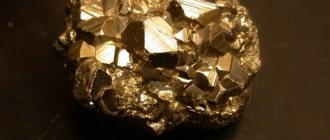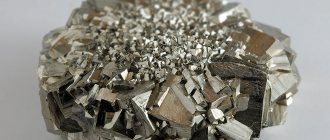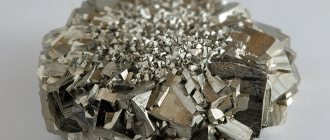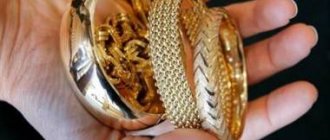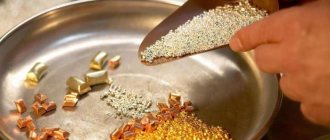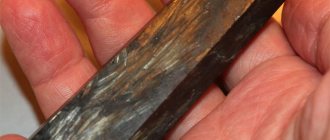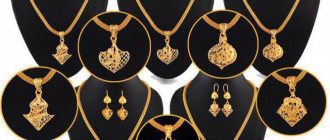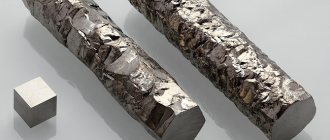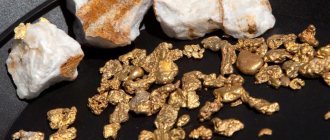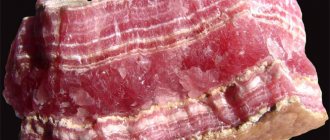For most people far from geology, ideas about sulfur pyrite, or pyrite (golden stone, alpine diamond) are rather vague. Many people have heard about it, only a few have seen it, despite the fact that this compound is very common in nature. Its chemical composition includes a lot of elements such as copper, nickel, cobalt, selenium, arsenic and even gold, although only as impurities.
Close relatives of pyrite in physical and chemical properties. What minerals can be confused with pyrite
In terms of chemical, physical properties, as well as external characteristics, pyrite has so-called brothers - related minerals. They can easily be confused with each other.
Chalcopyrite. This is also a mineral, but it has a darker, intense yellow tint, giving off a reddish tint. This is due to the large proportion of copper in the stone. Hardness is lower: 3.5-4 on the Mohs scale.
Cobaltine. A mineral containing cobalt and iron.
Softer than pyrite: its hardness is 3.5. Differs in color: from white to dark gray.
Crystal Habit
Pyritohedra crystals from Italy
Pyrite usually forms cuboidal crystals, sometimes forming in close association to form raspberry-shaped masses called framboids. However, under certain circumstances, it can form anastomosing threads or T-shaped crystals.[38] Pyrite can also form shapes almost the same as a regular dodecahedron, known as pyritohedrons, and this offers an explanation for artificial geometric patterns found in Europe as early as 5th century BC.[39][ clarification needed
]
Where is pyrite mined? Russian deposits
It is important that there are no pure pyrite deposits. Fool's gold is not so expensive and valuable, so it is mined only together with other rocks and metals. Pyrite is often present in ores next to gold. Found together with nickel, cobalt, copper. The largest Russian deposits:
- Ural: Kalatinskoye, Berezovskoye, Degtyarskoye gold ore deposits;
- Magadan region, city of Susuman;
- Altai and Caucasus mountains.
In addition, pyrite is found in deposits of marine clays and brown coal, which are found in Central Russia. Numerous factories are engaged in the processing of mineral rock, for example, in Yekaterinburg and Rostov.
Mineral mining
How to distinguish an original from a fake
Pyrite ball on a stand
Pyrites are not created artificially - this is impractical, since the stone is not in great demand among jewelers, is quite common in nature and is inexpensive.
Sometimes pyrite can be passed off as gold, but it is soft, and iron pyrite is hard. Pressing the precious metal will leave a dent; this will not happen with “Inca gold”.
At local markets and resort fairs, you can run into jewelry sellers who want to increase the value of their plastic and glass trinkets by passing them off as energetically powerful iron pyrites. This kind of deception is easy to spot:
- Glass and plastic are light, mineral is heavy.
- Its metallic color cannot be picked off with a fingernail, like a layer of paint on glass, but the stone itself will easily scratch the glass.
- Pyrite is always opaque; glass and plastic can be translucent when viewed in the light.
Methods for the formation of pyrite in nature
The origin of the mineral is explained in several ways.
When magma crystallizes during cooling
Volcanic magma, cooling, crystallizes. Hot vapors disappear, the remaining oxides form pyrite.
As a result of the interaction of hydrogen sulfide vapor, sulfur and iron-containing compounds
Pyrite can be formed by pneumalite, that is, with the participation of gaseous substances. For example, hydrogen sulfide and iron-containing substances combine with sulfur compounds to release hot fumes. They interact to form mineral rock.
References
- Definition of PYRITE | in the Cambridge English Dictionary. dictionary.cambridge.org
. - Hurlbut, Cornelius S.; Klein, Cornelis (1985). Manual of Mineralogy
(20th ed.). New York, NY: John Wiley and Sons. pp.285–286. ISBN 978-0-471-80580-9. - "Pyrite". Webmineral.com
. Retrieved 2011-05-25. - "Pyrite". mindat.org
. Retrieved 2011-05-25. - Anthony, John W.; Bidot, Richard A.; Bladh, Kenneth W.; Nichols, Monte S., ed. (1990). "Pyrite" (PDF). Handbook of Mineralogy
. Volume I (Elements, sulfides, sulfosalts). Chantilly, Virginia, USA: Mineralogical Society of America. ISBN 978-0962209734. - Jackson, Julia A.; Mel, James; Neuendorf, Klaus (2005). Glossary of Geology
. American Geological Institute. p. 82. ISBN 9780922152766 - via Google Books. - Fay, Albert H. (1920). Mining and Mineral Industries Glossary
. US Department of Mines. pp. 103–104—via Google Books. - πυρίτης. Liddell, Henry George; Scott, Robert; Greek-English Lexicon
on the Perseus Project. - πῦρ in Liddell and Scott.
- Dana, James Dwight; Dana, Edward Salisbury (1911). Descriptive Mineralogy
(6th ed.). New York: Wiley. paragraph 86. - "De re Metallica." Mining Magazine
. Translated by Hoover, H.; Hoover, L. London: Dover. 1950 [1912]. see footnote on page 112. - "Armored snail discovered in deep sea." news.nationalgeographic.com
. Washington, DC: National Geographic Society. Retrieved 2016-08-29. - Fleet, M.E.; Mumin, A. Hamid (1997). "Auriferous Arsenian Pyrite, Marcasite and Arsenopyrite from the Carlin Trend Gold Deposits and Laboratory Synthesis" (PDF). American mineralogist
.
82
(1–2): 182–193. doi:10.2138/am-1997-1-220. S2CID 55899431. - Larson, Bruce (01/01/2003). "The Interpretation of Firearms in the Archaeological Record in Virginia 1607-1625." Dissertations, Dissertations and Master's Projects
. - Schultz, Chester (October 22, 2021). "Place name summary 6/23: Brukangga and Tyndale use bruki" (PDF). Adelaide Research and Scholarships
. University of Adelaide. Retrieved November 16, 2021. - "Industrial England in the mid-eighteenth century". Nature
.
83
(2113): 264–268. 1910-04-28. Bibcode:1910Natura..83..264.. Doi:10.1038 / 083264a0. HDL:2027/coo1.ark:/13960/t63497b2h. S2CID 34019869. - Rosenquist, Terkel (2004). Principles of Extractive Metallurgy
(2nd ed.). Tapir Academic Press. paragraph 52. ISBN 978-82-519-1922-7. - "Cylindrical primary lithium [battery]." Lithium iron disulfide (Li-FeS2)
(PDF). Reference book and instructions for use. Energizer Corporation. 2017-09-19. Retrieved 2018-04-20. - Elmer, C. and Trybuch, H. (2000-03-11). "Iron disulfide (pyrite) as a photovoltaic material: challenges and opportunities." Proceedings of the 12th Workshop on Quantum Conversion of Solar Energy - (QUANTSOL 2000)
. Archived from the original on January 15, 2010. - ^ a b
Xin Zhang and Mengquin Li (06/19/2017).
"Possible solution to the problem of doping iron pyrite: determining the type of carrier using the Hall effect and thermopower." Materials of physical review
.
1
. Doi:10.1103/PhysRevMaterials.1.015402. - Principles underlying radio communications
.
US Army Signal Corps. Radio brochure. 40
. 1918. section 179, pp 302–305 - via Google Books. - Thomas H. Lee (2004). Design of Radio Frequency Integrated Circuits
(2nd ed.). Cambridge, UK: Cambridge University Press. pp. 4–6. ISBN 9780521835398 - via Google Books. - Wadia, Cyrus; Alivisatos, A. Paul; Kammen, Daniel M. (2009). “Availability of materials expands opportunities for large-scale deployment of photovoltaics.” Environmental Science and Technology
.
43
(6):2072–7. Bibcode:2009EnST...43.2072W. Doi:10.1021/es8019534. PMID 19368216. S2CID 36725835. - Sanders, Robert (February 17, 2009). “Cheaper materials could be the key to cheaper solar cells.” Berkeley, CA: University of California - Berkeley.
- Hesse, Rainer W. (2007). History of Jewelry: An Encyclopedia
. Greenwood Publishing Group. paragraph 15. ISBN 978-0-313-33507-5. - Calvo, Miguel and Sevillano, Emilia (1998). "Pyrite crystals from the provinces of Soria and La Rioja, Spain." Mineralogical record
.
20
: 451–456.CS1 maint: several names: list of authors (link to site) - “Which country imports the most unroasted iron pyrite in the world? - IndexBox. www.indexbox.io
. Retrieved 2018-09-11. - "'Fool's gold' may prove valuable after all." Phys.org
. Retrieved August 17, 2021. - Walter, Jeff; Voight, Brian; Day-Roberts, Ezra; Heltemes, Kay; Fernandes, Rafael M.; Birol, Turan; Leighton, Chris (July 1, 2021). "Stress-induced ferromagnetism in a diamagnetic material". Science achievements
.
6
(31): eabb7721. Doi:10.1126/sciadv.abb7721. ISSN 2375-2548. PMC 7439324. PMID 32832693. - Kaur, Harneet; Tian, Ruiyuan; Roy, Ahin; McChrystal, Mark; Horvath, Dominic W.; Onrubia, Guillermo L.; Smith, Ross; Rueter, Manuel; Griffin, Aideen; Backes, Claudia; Nicolosi, Valeria; Coleman, Jonathan N. (September 22, 2021). "Production of quasi-2D non-layered iron pyrite (FeS2) platelets by liquid-phase exfoliation for high-performance battery electrodes." Self-propelled gun Nano
.
14
(10):13418–13432. Doi:10.1021/acsnano.0c05292. PMID 32960568. - Vaughan, D. J.; Craig, J. R. (1978). Mineral chemistry of metal sulfides
. Cambridge, UK: Cambridge University Press. ISBN 978-0-521-21489-6. - Bragg, W. L. (1913). "The structure of some crystals as revealed by their X-ray diffraction." Proceedings of the Royal Society
A.
89
(610): 248–277. Bibcode:1913RSPSA..89..248B. doi:10.1098/rspa.1913.0083. JSTOR 93488. - Birkholz, M.; Fiechter, S.; Hartmann, A.; Tribuch, H. (1991). "Sulfur deficiency in iron pyrite (FeS2-x) and its implications for models of band structure." Physical Review
B.
43
(14):11926–11936. Bibcode:1991PkhRvB..4311926B. Doi:10.1103/PhysRevB.43.11926. PMID 9996968. - Brese, Nathaniel E.; von Schnering, Hans Georg (1994). "Binding trends in pyrite and re-examination of the structure of PdA.2, PdSb2, PtSb2 and PtBi2." Z. Anorg.
Allg. Chem .
620
(3):393–404. Doi:10.1002/zaac.19946200302. - Burgardt, P.; Sehra, M.S. (1977-04-01). "Magnetic susceptibility of iron pyrite (FeS2) between 4.2 and 620 K". Solid State Communications
.
22
(2): 153–156. Doi:10.1016/0038-1098(77)90422-7. ISSN 0038-1098. - Stevens, E. D.; Delucia, M. L.; Coppens, P. (1980). "Experimental observation of the effect of crystal field splitting on the electron density distribution of iron pyrite." Inorg.
Chem .
19
(4):813–820. doi:10.1021/ic50206a006. - Birkholz, M. (1992). "Crystalline Energy of Pyrite". J. Phys.: Condens.
Case .
4
(29):6227–6240. Bibcode:1992JPCM…. 4.6227B. Doi:10.1088/0953-8984/4/29/007. - Bonev, I.K.; Garcia-Ruiz, J.M.; Atanasova, R.; Otalora, F.; Petrussenko, S. (2005). "Genesis of filamentary pyrite associated with calcite crystals". European Journal of Mineralogy
.
17
(6):905–913. Bibcode:2005EJMin..17..905B. CiteSeerX 10.1.1.378.3304. Doi:10.1127/0935-1221/2005/0017-0905. - The pyritohedral shape is described as a dodecahedron with pyritohedral symmetry; Dana J. et al. (1944), System of Mineralogy
, New York, p. 282 - Mindat is bravoit. Mindat.org (May 18, 2011). Retrieved May 25, 2011.
- Pyrite on. Minerals.net (February 23, 2011). Retrieved May 25, 2011.
- Acid mine drainage
- Andrew Roy, Coal Mining Company in Iowa, Journal of the Coal Trade
, quoted in History of Lucas County, Iowa, State Historical Company, Des Moines (1881), pp. 613–615. - Zodrow, E (2005). "Coal Mines and Surface Hazards from Coal and Pyrite Oxidation (Pennsylvanian Sydney Coalfield, Nova Scotia, Canada)." International Journal of Coal Geology
.
64
(1–2): 145–155. doi:10.1016/j.coal.2005.03.013. - Bowles, Oliver (1918) Structural and decorative stones of Minnesota. Bulletin 663, USGS, Washington. paragraph 25.
- Tagnitama, A; Sariccoric, M; Rivard, P. (2005). "Internal deterioration of concrete due to oxidation of pyrrhotite aggregates." Cement and Concrete Research
.
35
: 99–107. doi:10.1016/j.cemconres.2004.06.030. - Angelo, William (January 28, 2009) The Mystery of the Material Smell Over Foul-Smelling Drywall. Engineering news-record.
- "PYRITE and Your Home: What Homeowners Need to Know Archived 2012-01-06 in the Wayback Machine" - ISBN 2-922677-01-X - Required Deposit - National Library of Canada, May 2000
- Schreimer, F. and Bromley, A.W. (2012) "Pyrite wave in Ireland". Materials of the Euroseminar on building materials
. International Association for Cement Microscopy (Halle, Germany) - Homeowners are protesting pyrite damage to their homes. The Irish Times (11 June 2011
- Brennan, Michael (February 22, 2010) Devastating pyrite epidemic strikes 20,000 new homes. Irish Independent
- IS. EN 13242:2002 Aggregates for unbound and hydraulically bound materials for use in civil works and road construction.
- Briggs, D. E. G.; Raiswell, R.; Bottrell, S.H.; Hatfield, D.; Bartels, K. (1996-06-01). “Control of pyritization in exclusively preserved fossils; analysis of the Lower Devonian Hunsrueck Shale in Germany." American Journal of Science
.
296
(6):633–663. Bibcode:1996AmJS..296..633B. doi:10.2475/ajs.296.6.633. ISSN 0002-9599.
Areas of application of pyrite
The scope of application of cat gold is quite wide. This is due to its extensive beneficial properties.
Fool's gold mineral pyrite
Mineralogy and collectors: exhibition samples
Pyrite is a popular stone among rock collectors. This is due to how unusual the mineral can look. The unusual radiance and amazing shapes of the crystals are the reason why cat stone exhibits occupy pride of place not only in amateur collections, but on the shelves of mineral museums.
Industry: iron ore and sulfur, pyrite impurities, concrete production
Pyrite is used in industrial production. Thus, it produces sulfuric acid. Roasting the mineral produces sulfur oxide and iron oxide. Sulfur oxide, after oxidation, forms sulfuric acid. Iron oxide, interacting with carbide, turns into metal.
Due to its ability to create fire, it is used in the production of silicon weapons. In microelectronics it is used for the manufacture of detectors for radio receivers. The mineral rock is also actively used in construction. Pyrite contains solutions of concrete, cement, expanded clay, mastic, and asphalt concrete.
Jewelry making: jewelry and accessories
Jewelry made from cat gold has been made since ancient times. Pyrite products look as impressive as gold ones: due to their shine and shimmer. In addition, various accessories are made from pyrite: mirror frames, hairpins, hair combs, boxes, figurines, cigarette cases.
Images
- As a replacement mineral in ammonite from France
- Pyrite from the Ampliación a Victoria mine, Navajún, La Rioja, Spain
- Pyrite from the Sweet Home mine, with gold striped cubes intergrown with minor tetrahedrite, on a layer of clear quartz needles
- Emitting form of pyrite
- Paraspirifer bownockeri
in pyrite
- Pink fluorite is sandwiched between pyrite on one side and metallic galena on the other.
- SEM image of the intergrowth of cuboctahedral crystals of pyrite (yellow) and pyrrhotite (pinkish-yellow)
Ancient and modern healers about the healing properties of the stone
When studying the structure and properties of cat gold, it was revealed that its therapeutic capabilities are unique. Pyrite can safely be called a natural antidepressant. Experts recommend wearing this stone as a talisman for people who suffer from nervous system problems or sleep disturbances. The stone relieves stress, restores strength, restores efficiency, and relieves insomnia.
The mineral also has contraindications for treatment. Not recommended for people with unstable mental disorders or neuropsychiatric diagnoses.
How to care for stone
Pendant with pyrite
Caring for pyrite has certain difficulties, since the mineral is fragile and prone to self-oxidation and destruction.
Even with the most careful treatment, iron pyrite will still collapse after a few years. This happens due to contact with atmospheric oxygen, so jewelry with it should not be given heirloom status. You need to purchase them to wear them according to the “here and now” principle.
Experienced collectors, who have unlimited funds and want to preserve unique pyrite samples for many years, place them in special vacuum packaging, which needs to be renewed periodically. In museums, they do it simpler - they boil samples in melted paraffin, which forms a protective layer on them, although a vacuum still remains the most effective in this regard.
Some “craftsmen,” trying to prolong the life of “Inca gold” at home, coat the surface of their stones with colorless varnish or various oils. The described procedures are questionable, since this layer quickly wears off, and the stone again begins to interact with air.
To make your favorite jewelry pleasing to the eye for as long as possible, you need to:
- Avoid bumps and falls.
- Store in soft protective packaging separately from other jewelry.
- Avoid even the slightest contact with water, as if it gets on the mineral, a reaction will occur with the release of sulfuric acid, accompanied by an unpleasant odor.
- Keep in a dark place away from direct sunlight, which accelerates the destruction of the stone.
Esotericists about the magical effect of pyrite jewelry on the human body
The use of pyrite is possible for magical purposes, esotericists say. This is a favorite crystal of psychics and magicians. It is believed that it is able to accumulate and preserve vital energy. Many psychics, after practical sessions, use this stone for recovery; they receive magical power through it.
Pyrite nugget
It is important to use the perfect mineral without cracks or chips. It is advisable to use pyrite as a talisman in the following cases:
- when a person takes risks or is in danger, for example, police officers, firefighters, rescuers;
- The mineral is suitable for leaders and strong personalities;
- The stone protects families.
Magicians claim that pyrite is a masculine mineral. It can make a person strong, fearless, and instill confidence in him. There is also an opinion that this stone warns of dangers, misfortunes, death: it becomes cloudy.
The crystal is also useful to some extent for women. Helps arrange personal life, preserves the child for pregnant women, facilitates childbirth, treats infertility.
A stone can also be of great importance for a child. If the baby is restless, then a piece of pyrite was hung in the form of a pendant around the neck. The stone not only gave balance and tranquility, it also improved sleep, protecting against nightmares.
Appearance of the mineral and its deposits
Pyrite has a very remarkable appearance. It is an opaque stone with a bright metallic luster. It looks like a chaotic jumble of shiny cubic crystals fused together. Their edges are so smooth, as if created by human hand. Some specimens are composed of octahedral rhombuses (octahedra).
The stone has a light brass, straw yellow or golden color, so this find was often confused with gold, for which pyrite received the nickname “fool’s gold.” Sometimes you come across silver or blue pyrite.
It can be large in size - several tens of centimeters in cross section. Hatching in the form of parallel lines is “drawn” on the edges of the stone. When oxidized, pyrite loses its shine, becomes dull, and acquires an unattractive yellowish-gray tint. A glancing blow produces sparks.
Sulfur pyrite is widespread everywhere. It is found on land, in swamps, at the bottom of seas and oceans. It is part of all igneous rocks. Pyrite occurs in sedimentary rocks. It is not sought separately, but is obtained when working with pyrite ore, extracting more valuable rocks.
The largest and highest quality stones that have jewelry value are found in Italy. Pyrite is mined for industrial purposes in Russia, Canada, Japan, and the USA.
The most famous pyrite deposits are located in Kazakhstan, Azerbaijan, Altai, and the Urals. Among European countries, Norway, Spain, Germany, Switzerland, France, Sweden, Poland, and the island of Cyprus are famous for their reserves of such minerals.
This is one of the most dangerous minerals. It has an extremely unpleasant feature: when combined with coal in air, pyrite begins to oxidize. This is accompanied by its spontaneous combustion. Highly toxic substances (arsenic) are released into the atmosphere.
If pyrite is found in a coal mine, limestone powder is scattered there, which slows down the oxidation of the ore and prevents its self-ignition.
Cost of pyrite and products made from it
Cat gold, as already mentioned, serves as a raw material in the jewelry industry. How much can you buy or sell a product made from this mineral?
There is a misconception that pyrite products are cheap. This is not always the case, because significant costs are associated with the extraction of the mineral and its processing. In addition, jewelry is not made from pure mineral; most often it is combined with precious metals and stones.
For example, in Moscow and St. Petersburg, a silver ring can be bought for an average of 20 thousand rubles. A pyrite ring will be 2-3 thousand more expensive. Bracelets cost around 2 thousand, prices for earrings – up to 30 thousand. You can buy beads for 4-5 thousand rubles.
Content
- 1 Uses
- 2 Research
- 3 Formal oxidation states of pyrite, marcasite and arsenopyrite
- 4 Crystallography
- 5 Crystal Habit
- 6 Varieties
- 7 How to distinguish similar minerals
- 8 Hazards 8.1 Pyrite oxidation and acid mine drainage
- 8.2 Dust explosions
- 8.3 Weakened building materials
Jeweler's comment
Molokanov N.M.
Jeweler, 26 years of experience in jewelry production.
It’s not for nothing that the mineral is called fool’s gold. Its deceptive shine makes it possible to make beautiful jewelry stylized in gold. On the one hand, this is an opportunity to create budget jewelry options, on the other hand, the development of fraudulent schemes. And although the time when people, out of ignorance, mistaking fools for gold placers for a precious metal has passed, unscrupulous masters of making money from counterfeits still remain. And if you consider that jewelers never use pure gold, but only alloys, then it is not difficult to deceive an unscrupulous buyer. Therefore, be sure to buy jewelry from trusted sellers, request the necessary documentation, and study the composition of the product. Getting the right information will protect you from scammers.
Pyritized fossils
| This section need additional quotes for verification . |
Pyrite and marcasite usually occur as replacement pseudomorphs after fossilization into black shale and other sedimentary rocks formed under reducing environmental conditions.[53] However, pyrite dollars
or
pyrite suns
which have an appearance similar to sand dollars are pseudofossils and lack the pentagonal symmetry of the animal.
Features of pyrites
Pyrites are minerals that are selenium, arsenic, antimony, and selenium compounds of iron group metals. Among the representatives of this group we note: nickel, cobalt, platinum, iron. They have a characteristic metallic luster and are colored yellow, gray, and red. All pyrites have excellent hardness, but are considered brittle minerals.
These include systems of hexagonal and rhombic structure:
- regular systems, represented by pyrite, cobalt luster, speiss cobalt, ulmannite, chloanthite;
- Orthorhombic variants include arsenic pyrite and marcasite;
- Millerite, nickelite, magnetic pyrite have a hexagonal system;
- copper pyrite has a square shape.
